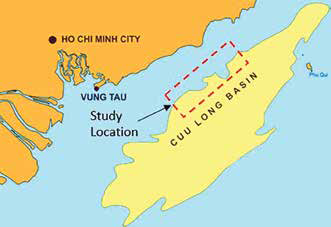Application of machine learning techniques in estimation of fracture porosity using fuzzy inference system for a FGB reservoir in Cuu Long basin, Vietnam
Tóm tắt
Determination of porosity of a fractured granite basement (FGB) reservoir in the Cuu Long basin has always been a challenge for petrophysicists. In this study, an analysis of fracture porosity was successfully conducted, using a machine-learning technique, i.e., fuzzy inference system (FIS), the well log data including gamma ray (GR), deep resistivity (LLD), shallow resistivity (LLS), sonic (DT), bulk density (RHOB), neutron porosity (NPHI), photoelectric factor (PEF) and caliper (CAL) from two wells BHX01 and BHX02, were used as the input for FIS analyses. Fracture porosity calculated by conventional method was found between 0.01 and 2.24% for BHX01 and between 0.15 and 6.63% for BHX02, respectively. These values match very well with those predicted by various FIS techniques, i.e. Sugeno, Mamdani and Subtractive FIS models. It is expected that the approach of using FIS in petrophysical analysis as presented in this paper can be further applied for other fractured granite basement reservoirs in the Cuu Long and Nam Con Son basins, offshore southern Vietnam.
Các tài liệu tham khảo
2. Lotfi A. Zadeh. Fuzzy logic, neural network and soft computing. Communication of the ACM. 1994; 37(3): p. 77 - 84.
3. Abdelwahab Hamam, Nicolas D.Georganas. A comparison of Mamdani and Sugeno fuzzy inference systems for evaluating the quality of experience of Hapto-Audio-
Visual applications. 2008 IEEE International Workshop on Haptic Audio Visual Environments and Games. 18 - 19 October, 2008: p. 87 - 92.
4. Muriel Bowie. Fuzzy clustering, feature selection, and membership function optimization. Seminar Paper, Department of Informatics, University of Fribourg,
Switzerland. 2004.
5. J.H.Fang, H.C.Chen. Fuzzy modeling and the prediction of porosity and permeability from the compositional and textural attributes of sandstone. Journal
of Petroleum Geology. 1997; 20(2): p. 185 - 204.
6. L.P.Martinez, R.G.Hughes, M.L.Wiggins. Identification and characterization of naturally fractured reservoir using conventional well logs. University of Oklahoma. 2002.
7. Richard J.O'Connell, Bernard Budiansky. Seismic velocities in dry and saturated cracked solids. Journal of Geophysical Research. 1974; 79(35): p. 5412 - 5426.
8. Nancy Hambalek, Reinaldo Gonzalez. Fuzzy logic applied to lithofacies and permeability forecasting. SPE 81078. SPE Latin America and Caribbean Petroleum
Conference, Trinidad. 27 - 30 April, 2003.
9. Abdulazeez Abdulraheem, Emad Sabakhy, Mujahed Ahmed, Aurifullah Vantala, Putu D. Raharja, Gabor Korvin. Estimation of permeability from wireline logs
in a Middle East carbonate reservoir using fuzzy logic. SPE 105350. SPE Middle East Oil and Gas Show and Conference, Manama, Bahrain. 11 - 14 March, 2007.
10. Bui Duc Trung. Petrophysical analysis of a fractured granite reservoir, offshore southern Vietnam. Master Thesis, GE-10-12. Asian Institute of Technology (AIT). 2011.
11. Pham Huy Giao, Kushan Sandunil. Application of deep learning in predicting fracture porosity. Petrovietnam Journal. 2017; 10: p. 14 - 22.

1. Tác giả giao bản quyền bài viết (tác phẩm) cho Tạp chí Dầu khí, bao gồm quyền xuất bản, tái bản, bán và phân phối toàn bộ hoặc một phần tác phẩm trong các ấn bản điện tử và in của Tạp chí Dầu khí.
2. Bằng cách chuyển nhượng bản quyền này cho Tạp chí Dầu khí, việc sao chép, đăng hoặc sử dụng một phần hay toàn bộ tác phẩm nào của Tạp chí Dầu khí trên bất kỳ phương tiện nào phải trích dẫn đầy đủ, phù hợp về hình thức và nội dung như sau: tiêu đề của bài viết, tên tác giả, tên tạp chí, tập, số, năm, chủ sở hữu bản quyền theo quy định, số DOI. Liên kết đến bài viết cuối cùng được công bố trên trang web của Tạp chí Dầu khí được khuyến khích.




